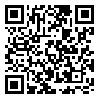Tue, Dec 23, 2025
[Archive]
Volume 13, Issue 39 (2021)
JMED 2021, 13(39): 49-55 |
Back to browse issues page
Download citation:
BibTeX | RIS | EndNote | Medlars | ProCite | Reference Manager | RefWorks
Send citation to:



BibTeX | RIS | EndNote | Medlars | ProCite | Reference Manager | RefWorks
Send citation to:
Hoseini Kasnavieh M, Rezai M, Amanollahi A, Seyedian S. Comparison of in-person and non- attendance of training programs to improve the skills of transmitting bad news by emergency medical students. JMED 2021; 13 (39) :49-55
URL: http://edujournal.zums.ac.ir/article-1-1203-en.html
URL: http://edujournal.zums.ac.ir/article-1-1203-en.html
1- Trauma and Injury Research Center, Iran University of Medical Sciences, Tehran, Iran
2- Emergency Medicine Management Research Center, Iran University of Medical Sciences, Tehran, Iran
3- Department of Epidemiology, School of Public Health and Safety, Shahid Beheshti University of Medical Sciences, Tehran, Iran
4- Emergency Medicine Department, Iran University of Medical Sciences, Tehran, Iran ,dr.seyedein@yahoo.com
2- Emergency Medicine Management Research Center, Iran University of Medical Sciences, Tehran, Iran
3- Department of Epidemiology, School of Public Health and Safety, Shahid Beheshti University of Medical Sciences, Tehran, Iran
4- Emergency Medicine Department, Iran University of Medical Sciences, Tehran, Iran ,
Abstract: (5911 Views)
Background and Objective:The physician- patient relationship requires special communication skills. This relationship, especially when announcing bad news, will cause irreparable discomfort in the patient and his families. Therefore, there is a need for studies in the field of training for physicians so they can make appropriate decisions in these cases.
Materials and Methods:All emergency medical students in the Iran University of Medical Sciences in 2019 were entered to study. Participants were divided with couple and odd method to in-person (lecture, group discussion) and non- attendance (receiving training packages, slides, and video) training groups with SPIKES. Questionnaire was used to assess the performance and attitude of how to transfer bad news based on the strategy of the SPIKES. The results of pre-test and post-test in both groups were compared and also compared to each other.
Results:The mean scores after the training in in-person group were 121.75 in attitude and in the performance approach 63.45, and in non- attendance group were respected 115.6 and 62.70.Attitude scores in the study groups were not significant (p-value> 0.05) after education than before. However, there was a significant difference (p-value< 0.001) in the comparisons mean scores of performances in the groups.
Conclusion:The results showed the necessity of conducting this study on the other medical specialty students and the inclusion of bad news transmitting skills in the education curriculum.
Materials and Methods:All emergency medical students in the Iran University of Medical Sciences in 2019 were entered to study. Participants were divided with couple and odd method to in-person (lecture, group discussion) and non- attendance (receiving training packages, slides, and video) training groups with SPIKES. Questionnaire was used to assess the performance and attitude of how to transfer bad news based on the strategy of the SPIKES. The results of pre-test and post-test in both groups were compared and also compared to each other.
Results:The mean scores after the training in in-person group were 121.75 in attitude and in the performance approach 63.45, and in non- attendance group were respected 115.6 and 62.70.Attitude scores in the study groups were not significant (p-value> 0.05) after education than before. However, there was a significant difference (p-value< 0.001) in the comparisons mean scores of performances in the groups.
Conclusion:The results showed the necessity of conducting this study on the other medical specialty students and the inclusion of bad news transmitting skills in the education curriculum.
Article Type : Orginal Research |
Subject:
Education
Received: 2019/08/24 | Accepted: 2020/12/5 | Published: 2021/01/3
Received: 2019/08/24 | Accepted: 2020/12/5 | Published: 2021/01/3
Send email to the article author
| Rights and permissions | |
 |
This work is licensed under a Creative Commons Attribution-NonCommercial 4.0 International License. |





